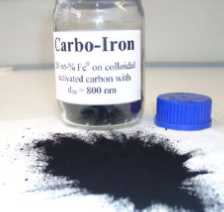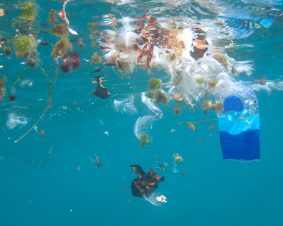 >
Spotlight September 2020: Groundwater remediation with Carbo-Iron® – Risk or Benefit?
>
Spotlight September 2020: Groundwater remediation with Carbo-Iron® – Risk or Benefit?
In September we would like to present a paper of the BMBF project Fe-Nanosit. The project dealt with the use of iron-containing nanomaterials in groundwater and wastewater remediation. A comprehensive assessment and weighing of benefits and possible environmental risks resulting from the application is now presented by the project partners in this paper.
Groundwater is indispensable for the drinking water supply in many areas of the world. Therefore, contamination of groundwater with pollutants requires purification before drinking water can be produced from it. There are different methods available for such a purification or remediation. The choice of the remediation method is made in such a way that as little damage as possible is caused to the respective ecosystem. In the present study, the in-situ remediation agent Carbo-Iron® was investigated and the benefits compared with possible harmful effects. From existing and newly collected ecotoxicity data in various organisms (water flea, algae, insects, bacteria), non-effect concentrations of 0.1 mg Carbo-Iron® per liter of water were derived. These concentrations were compared with measured and modelled environmental concentrations of Carbo-Iron®, as typically found in groundwater after remediation. For this purpose, a field study was evaluated, which was carried out in an aquifer contaminated with chlorinated hydrocarbons under an old laundry. The comprehensive final evaluation clearly showed that the total environmental risk was significantly reduced by the destruction of the chlorinated hydrocarbons by means of Carbo-Iron®.
This study is thus one of only a few to carry out a comprehensive risk assessment in a nanomaterials use case that involves a release into the environment (here into groundwater). In this case it could be clearly shown that the benefits of the application (the destruction of pollutants) clearly outweigh the risks (effects of Carbo-Iron® on organisms).
Original Publication:
Mirco Weil, Katrin Mackenzie, Kaarina Foit, Dana Kühnel, Wibke Busch, Mirco Bundschuh, Ralf Schulz, Karen Duis (2019) Environmental risk or benefit? Comprehensive risk assessment of groundwater treated with nano Fe0-based Carbo-Iron®. Science of The Total Environment, 677, 156-166, https://doi.org/10.1016/j.scitotenv.2019.04.360

Weitere Spotlights
Spotlight August 2022: Three-stage model for the formation of micro- and nanoplastic particles.
Plastic pollution is a global problem that will continue to affect humanity for more than 100 years. There is the visible pollution, e.g. plastic debris in the environment, which leads to death for many animals (because they mistakenly think the plastic is food and eat it or because they get caught in the plastic waste). […]
Read moreSpotlight July: Plastic Pollution and the Urgent Need for Comprehensive Action
Plastic pollution has become a significant threat to the oceans, biodiversity, and ecosystems worldwide. Despite efforts to reduce plastic consumption, escalating plastic production continues to increase the magnitude of plastic pollution in the environment. In response to this crisis, the UN-Environmental Assembly (Link) adopted a resolution in March 2022 to develop a legally binding treaty […]
Read moreSpotlight March 2022: Safe Materials from Scratch – Safe-by-Design-Concept in action
In recent decades, German research on nanomaterials and new, innovative materials has been widely expanded by material safety aspects. European initiatives also pay significant attention to this: both the European Union (EU) Green Deal, and the Chemicals Strategy for Sustainability (CSS) aim to create a sustainable, climate-neutral economy with sustainable and safe chemicals and products, […]
Read moreSpotlight May 2022: Nano-ghosts” – Risk assessment of submicron-sized particles in food biased towards fictional “nano”
The European Commission has issued a ban on the colorant titanium dioxide in food. Titanium dioxide, which provides a nice shine and bright white color, can potentially damage genetic material. We chose a review article from 2022 for the May 2022 Spotlight that addresses the risk assessment of food-grade titanium dioxide (E171) and the resulting […]
Read more


